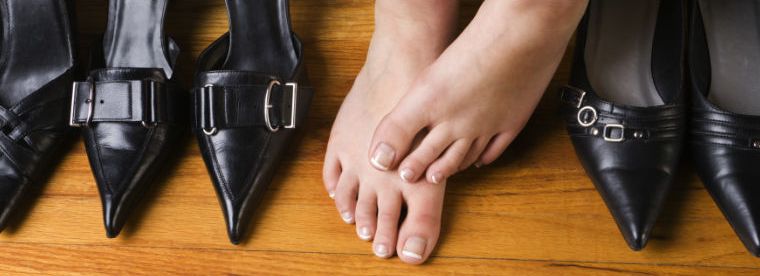Tune in to the full podcast interview with Dr. Raspovic.
Bunions—those unsightly bony protrusions that can develop over the first metatarsal bone or big toe joint—remain a bit of a mystery. Aside from their definition, everything else varies, including how and why they develop, who gets them and when, and what symptoms they may cause. But one thing is certain: Bunions can be hard to ignore, especially when they’re painful.
Fortunately, there are early steps you can take that may help you from ever reaching that stage.
“My best advice is to have an evaluation with a foot specialist when you first see a bunion developing or have any pain in your big toe joint,” says Katherine Raspovic, DPM, a podiatric surgeon. “There are a few conservative treatment options that can help improve discomfort.”
The luck of the draw, genetics, often plays a role in determining who gets bunions. But shoes are another likely culprit, with high heels and shoes with narrow toe areas leading the list of suspects. While many high-heel wearers may never have problems, Dr. Raspovic advises those who do to step away from the stilettos, pointy toes and any other shoe that aggravates the sore joint.
“One of the best preventative and therapeutic measures for bunions is wearing the right shoe for your foot, especially one that avoids excessive pressure on your toes,” she says. “It can be helpful to go to a good store where you can get your feet accurately measured so you can then find the proper size and fit.”
Beyond a change of footwear, other helpful tactics include using orthotics for arch support, modifying or taking a break from some activities for a time and taking anti-inflammatory medication.
Surgery is only recommended when other approaches have failed and the pain is so severe that daily activities and quality of life are affected. Depending on the type of surgical correction, some patients are completely off their feet for six weeks, followed by a walking boot and physical therapy. Post-surgical swelling—which may quickly subside or last for several months—can affect a patient’s ability to wear regular shoes for 10 to12 weeks after surgery. The recovery can be different for each patient based on what surgical intervention is needed to correct the bunion properly.
But with early detection and specialty medical care, many people can avoid surgery, says Dr. Raspovic.
Tune in to the full podcast interview with Dr. Raspovic.

